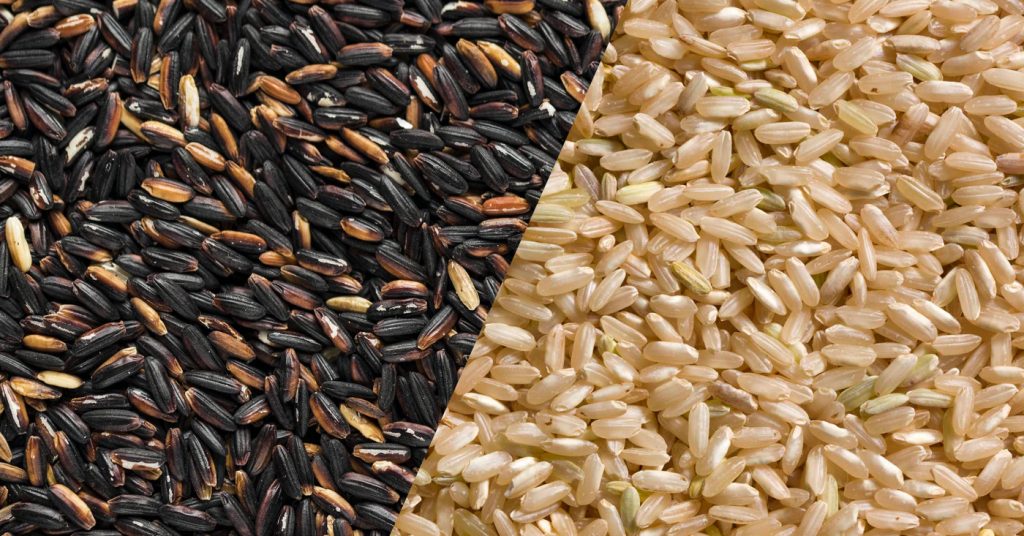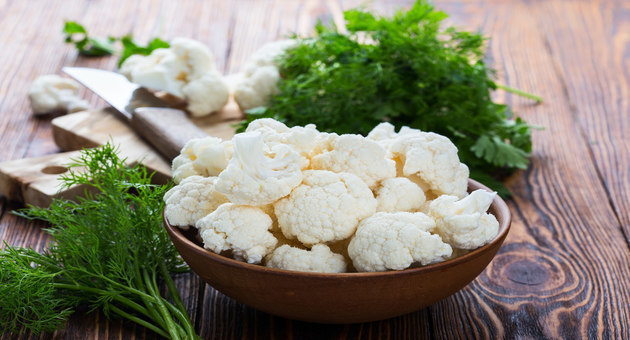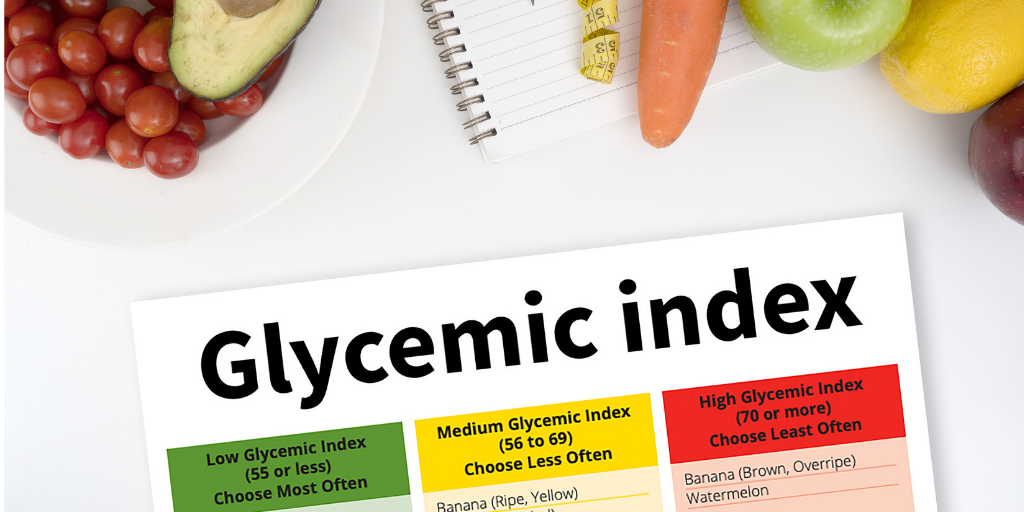Black and brown rice are a common carb source but does one offer an advantage in any way? The short answer is yes, so keeping reading to learn more.
Rice is a staple in the diets of fitness-minded (and non-fitness-minded) individuals all over the world. Why? It’s budget-friendly, versatile, and an amazing source of carbohydrates. Whether you’re about to nail an intense workout and need enough energy to sustain your efforts or if you just need an easy nutrition source that’s even easier to prepare, you can’t go wrong with rice.
It can be prepared a million different ways and different countries have historically added their own twist on how they make it. Well today, we’re going to discuss black rice vs. brown rice, which are two popular variations of this cereal grain.
You’ll be surprised to know that each one provides health benefits but not entirely in the same way.
Here’s some information we think you’d find useful when considering which rice to include in your diet.
Origin of Rice
Rice is the most important cereal crop and is a crucial source of nutrition for a large portion of the world’s population. It’s the seed of Oryza glaberrima (African rice) and Oryza Sativa (Asian rice).

So where did rice originate? Apparently, there’s much debate about this between archeologists who believe it was either first domesticated in East and Southeast Asia or India (South Asia). Although, most would agree that the scientific evidence points to rice most likely having its origins in the Yangtze River basin in China.
It has a very complex history…
The Asian species of rice Oryza Sativa is the most common, which literally has thousands of different forms that are separated into the two major subspecies: long-grain indica, and short-grain japonica. According to recent evidence, these species are believed to have first sprung from a single domesticated event anywhere from 8,200–13,500 years ago.
And the evidence of farming and cultivating implements dates back to 8,000 years ago.
The African species of rice was domesticated several years later (approximately 3,000 years ago). Although, it has mostly been replaced with Asian rice (Oryza Sativa). But African rice is still cultivated for use in a ritual context, typically for ancestor offerings.
Black Rice vs. Brown Rice
Now, that you know a little about the origins of rice, let’s talk about, well… black rice vs. brown rice.
Health benefits of black rice
Black rice is a tasty and nutritious, medium-grain, non-glutinous variation that comes from the Oryza Sativa species. It’s also referred to as “Forbidden” or purple rice. Now, you’re probably wondering why it’s called forbidden rice. Well, this dates back to many years ago in China when it was considered to be so rare and special that it was only reserved for royalty.
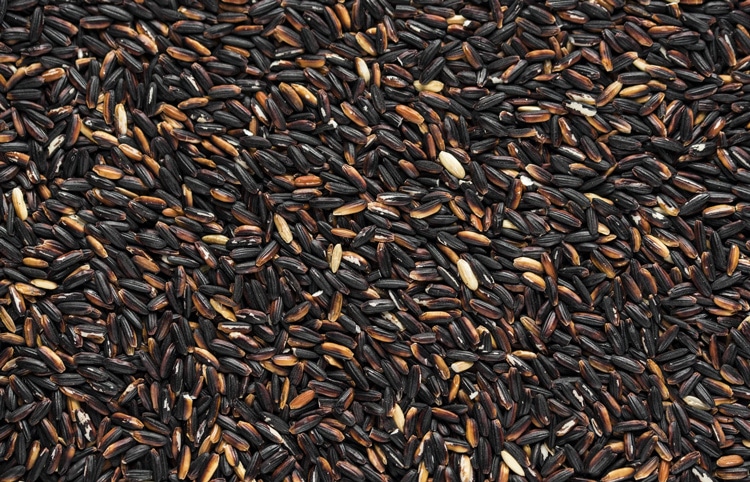
Of course though, nowadays, it’s used in many dishes around the world.
Black rice gets its dark color from plant pigments called anthocyanins. These compounds are also found in other plants such as blackberries, currants, red cabbage, and the list goes on,. It has been traditionally been used as a food colorant. But what’s most appealing about these pigments is that they possess many beneficial health-supporting properties.
Pigments have health benefits
There’s sufficient evidence to believe that anthocyanins can help to fight and prevent chronic health conditions. According to scientific literature, these ‘flavonoids’ have anti-cancer, anti-inflammatory, antioxidant, and even anti-obesity properties. In addition, they could have positive effects on cardiovascular health, metabolic diseases, and microbial infections, while improving visual ability and possessing neuroprotective properties.
One study found that anthocyanins can actually decelerate the spread of breast cancer cells while also reducing the total number.
These are among the most notable health benefits though. These polyphenols have been used for many years to treat a wide range of conditions. And apparently, anthocyanins elicit these health-promoting properties via multiple pathways.
Although, it’s not entirely concluded as to whether anthocyanins have these effects solely or in combinations with other polyphenols.
Now, according to research, chronic inflammation is associated with pretty much all dis-ease that occurs in the body. White blood cells (immune system cells that protect against substances) will see this prolonged inflammation as a threat and attack the good cells which we don’t want.
Therefore, the effects on inflammation likely play a large part in the all-around health benefits. But black rice also contains more antioxidants than either brown or white rice. Antioxidants protect cells against damage and therefore, may help to prevent essentially all forms of chronic disease.
May help with weight loss
Regarding the potential of black rice to support weight management, studies in humans are pretty limited.
Although, one study did find weight control benefits in women who ate a black and brown rice mixture compared to those who ate white rice. (15)
40 overweight Korean women were given low energy meal replacements that consisted of either white rice or the mixture (black and brown) over a span of 6 weeks. They could only have the meal replacements three times per day with nothing else other than snacks given to them by the researchers.
Well, the black and brown rice group saw significantly better improvements in weight, body mass index, and body fat (%) when compared to the white rice group.
We’d also like to note that both groups saw big improvements in total cholesterol and triacylglycerols, although there were no differences between the groups. It was concluded that the rice mixture was a better option for weight control in addition to improving antioxidant enzyme activity.
High in fiber
Fiber also plays a role in weight control as it helps with digestion and promotes satiety. Black rice has a few more grams per serving than does brown rice. Now, fiber is not only important for bowel health, but it’s also associated with improved blood sugar, lower cholesterol levels, and heart health support too.
For those unaware, there are two types of fiber (soluble and insoluble) both of which cannot be digested by the body. Black and brown rice contain both types but generally contain more insoluble fiber. Soluble fiber helps slow digestion and allows your body to absorb nutrients as a result.
This fiber helps with cholesterol, blood sugar, etc.
Insoluble fiber promotes better digestive health and improves bowel movements. It also helps with the weight loss process and can prevent diverticulitis (inflammation or infection in the intestine).
According to Harvard Health Publishing, most Americans get less than half of the daily recommendation fiber intake of 25g for women and 38g for men. Therefore, it’s important to ensure you get enough from a variety of sources every day.
In a recent analysis involving 185 prospective studies and 58 clinical trials with 4635 adult participants, the data suggested a “15-30% decrease in all-cause and cardiovascular related mortality, and incidence of coronary heart disease, stroke incidence and mortality, type 2 diabetes, and colorectal cancer when comparing the highest dietary fiber consumers with the lowest consumers.”
In addition, significantly lower bodyweight was observed which was also the case for systolic blood pressure, and total cholesterol.
This analysis concluded that the more fiber the better and that the best results were seen in those who consumed 25g and 29g of fiber daily.
Low glycemic
According to information from the Harvard T.H. Chan School of Public Health, glycemic index (GI) is a measure of how quickly and how much a food raises one’s blood sugar levels after eating.
A value of 55 and under is considered low glycemic.
Because of the fiber content of black rice, it’s lower on the glycemic index scale than brown and white rice, coming in at a value of 42.5 when boiled.
Boiled brown rice is typically in the range of 50-55 although it can vary. Boiled white rice, on the other hand, has a GI of 64 to 87 which is considered high. The more processed a food, the higher the GI typically.
Black rice is the better option if you need to watch your blood sugar.
Potentially improves eye health
Now let’s talk about the potentially beneficial effects that black rice may have on eye health. Black rice is high in antioxidants in general, which we know helps to stave off disease-causing free radicals in the body. Lutein and zeaxanthin are two carotenoids that act as antioxidants in the body, which are also connected with good eye health and that are found in the macula of the eye.
According to research, there’s a good deal of evidence that suggests lutein is effective in improving and even preventing age-related macular disease which ultimately leads to even worse conditions like blindness and vision impairment. And not only that, but lutein is said to also be associated with cognitive improvements due to its effects in the brain.
Black rice clearly has many health benefits that make it a very excellent nutritional choice whether you eat it as part of your fitness regime or just as a carb source with your weekly meals.
Black rice nutrition
A quarter cup of uncooked black rice contains:
- 180 calories
- 4 grams of protein
- 1 gram of fat
- 39 grams of carbs
- 5 grams of fiber
- 2% of the DV (daily value) of iron
- 2% of the DV of potassium
Black rice is a filling, yet quality plant-based protein option for supporting muscle growth and general health.
It’s also slightly higher in protein compared to many other forms of rice including brown rice. Although, there’s not really a significant difference there.
Black rice also contains 2.4g of iron per 100g. Iron plays an important role in several bodily functions such as helping our muscles store and use oxygen while also having a part in the make-up of some proteins and enzymes.
Then, of course, it’s a great carb source for providing us with fuel. Carbohydrates are our main energy source that allows us to sustain physical activity, along with dietary fat which is also a good source of energy.
Cooking Black rice
Black rice is a very tasty option and its dark purplish color after it’s cooked makes for an excellent presentation. It has a very pronounced nutty flavor and can either be dense and chewy or even stickier which is similar to white rice.
Now, because black rice is a whole-grain, it takes longer to cook compared to white rice, for example. That’s because it’s a more complex grain whereas white rice is essentially bare. It can take on average 45 minutes or even a little longer if not pre-soaked.
But, by rinsing and soaking in water, you can definitely reduce the cooking time to about half, and black rice is cooked just like other forms of rice. A good rule of thumb is to add 1 3/4 – two cups of water for every one cup of black rice.
There are plenty of great recipes online that you can explore. It goes great with any meat, veggie meals, soups, and even desserts (e.g black rice pudding with mango and coconut)!
Health benefits of brown rice
Brown rice is what white rice is before it becomes white rice and it comes in short, medium, and long grains. It’s a whole-grain (like black rice) with just the outer hull removed whereas white rice is stripped of the hull, in addition to the bran layer, and cereal germ.
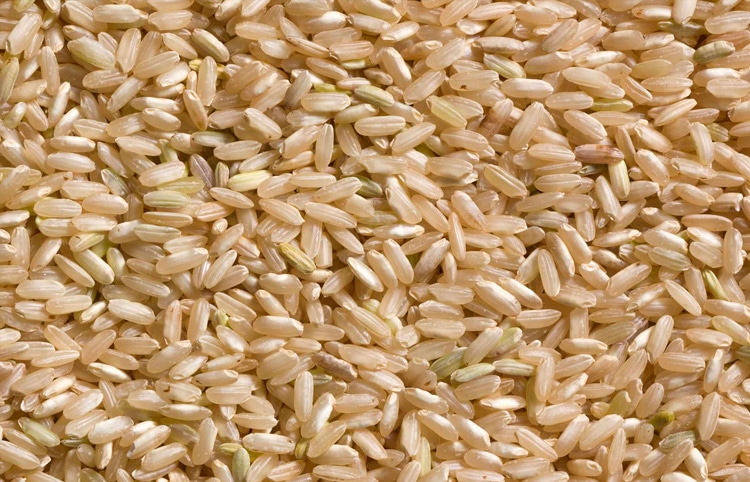
Consequently, brown rice is much more nutritious which you probably guessed. Although, “enriched” white rice has a lot of nutrients added back after it’s processed. This isn’t always the case though and as a result, it lacks the nutritional content that brown rice is abundant in.
Brown rice contains several mineral and vitamins although some in higher amounts than others. These include magnesium, niacin, iron, zinc, selenium, copper, phosphorus, B6, thiamine, and manganese. It also contains potassium, riboflavin, folate, vitamin K, and calcium in smaller amounts. These minerals and vitamins are all important for good health and maintaining essential bodily processes. In addition, you get a little fiber. Brown rice is also gluten-free.
It’s also more commonly consumed than black rice and it’s a nutrition staple especially for health-conscious individuals.
Brown rice has many health benefits that we feel definitely deserve to be acknowledged.
Loaded with nutrients
We need a good serving of macronutrients (protein, fat, and carbs) to sustain basic life. But we also need micronutrients (vitamins and minerals) for good overall health.
Minerals are vital for heart, bone, muscle, and brain health while also playing a role in making enzymes and hormones. Vitamins are vital for proper development, cell health, energy, and overall healthy bodily function.
Contains high manganese
It’s worth noting that manganese is the most abundant mineral in brown rice. In fact, one cup provides 88% of the daily value for manganese. The other minerals don’t come nearly as close. And it pretty much has many of the same benefits as other minerals for nerve health, heart function, bone development, etc.
Brown rice also contains antioxidants which we already know are very beneficial for fighting off oxidative stress that causes disease. Consequently, this means improvements or prevention of various markers of health.
Heart health
Brown rice contains lignans that are known to be beneficial for heart health. In fact, research shows that it can lower blood pressure, reduce fat in the blood, and decrease inflammation in the arteries.
One review of studies involving 285,000 men and women found that higher whole grain intake was associated with a 21% lower risk of CVD events. It was concluded that there’s a consistent inverse connection between whole-grain intake and cardiovascular disease.
There’s sufficient evidence that brown rice contains beneficial compounds that combat heart-related disease.
Better than white rice for controlling blood sugar
Brown rice is considered low glycemic especially compared to white rice which is a good reason to opt for this version instead.
Research shows an association between high glycemic foods and diabetes. One study found that higher white rice intake at 5x per week was associated with at least 17% higher risk of developing Type 2 diabetes when compared to having it less than one serving a month.
On the other hand, a serving of brown rice 2x per week vs. less than one serving of brown rice a month showed an 11% less chance of developing Type 2 diabetes.
This is viable evidence for justifying replacing white rice with brown rice.
Brown rice nutrition
A quarter cup of brown uncooked rice contains:
- 150 calories
- 3 grams of protein
- 1.5 grams of fat
- 32 grams of carbs
- 2 grams of fiber
- 4.2 grams of calcium
- 6% of the DV of iron
- 2% of the DV of potassium
Adding brown rice in your diet is not a bad idea at all as it’s a very nutritious option. It’s one of the best carb complex carb sources for sustaining physical activity since it’s slow-digesting. Not to mention, you get a little protein in there in addition to fiber and other key nutrients.
Cooking brown rice
Brown rice has a milder nutty flavor than black rice and texture-wise, it’s more medium to firm and is generally not sticky like white rice.
The medium and long grains are best for general cooking while the short-grain can be a little stickier. Like black rice, brown rice takes longer to cook than does white rice which is usually at least 45 minutes. You’ll generally use 2 1/2 cups of water to every cup of brown rice.
There are a lot of things you can do with brown rice. It’s great with almost anything due to its milder flavor compared to black rice and is a favorite with health-minded individuals due to its nutritional content.
Black Rice vs. Brown Rice: Which Is Better?
Based on our comparison of black rice vs. brown rice, the answer might be clear to you… you can’t go wrong with either. Each is a whole grain that has similar health benefits based on the research available. Although, you definitely want to eat other carb sources and not just rice every meal.
Black rice and brown rice are similar in nutritional content. Although, black rice has about 20-30 more calories per the same serving which is insignificant. The bigger difference is more so in the fiber, carbs, and even some minerals.
A quarter cup of uncooked brown rice has about 1-2g of fiber whereas the same amount of black rice contains about 4-5g.
You don’t have to eat black rice to get your fiber but if you eat little fiber otherwise, it’s good to have something with a little extra fiber to help you meet a healthy daily recommendation. Fiber is an important part of your diet as we previously discussed.
But as long as you get enough through your diet, you should be better off.
Black rice also has about 7 more grams of carbohydrates in a 1/4 cup than brown rice although this isn’t really significant if eating it in moderation. But we’d like to point out the fact that black rice is probably the better option for those that need to watch their blood sugar.
It’s hard to pick a “best one” here as each does have its little advantages. Overall though, there’s no reason to not include both in your diet. Variety is always a good thing when it comes to nutrition and you should definitely mix it up once in a while.
Drawbacks
Although both forms of rice are good choices in your nutritional regime, they do contain an antinutrient called ‘phytic acid’, that has been shown to reduce the body’s ability to absorb certain nutrients. This could definitely mean getting fewer nutrients overall from your rice. Although, phytic acid may provide some health benefits though due to its antioxidant properties.
But the possible lack of optimal nutrient absorption can be made up for by consuming a complete, nutrient-rich diet. The good news though, is that phytic acid doesn’t affect the macronutrients (protein, carbs, and fat), or the antioxidants. So, even if you’re not able to absorb as many micronutrients, you still get more nutrition than if you were to choose white rice.
Now, there has been some concern about brown rice being contaminated with arsenic which is a toxic chemical that’s classified as a group A human carcinogen. High amounts have been found in rice products which could possibly lead to health problems (e.g. diabetes, cardiovascular disease, etc).
However, according to recent evidence, this shouldn’t be too much of a concern, especially in the immediate or short term. John Duxbury, a soil chemist at Cornell University completed a market basket analysis of rice along with greenhouse experiments with rice grown in the U.S.
He found that the rice sample with the highest inorganic arsenic contained only 22% of the substance. He also determined that farmers could reduce the arsenic content by using less water and producing rice plants that absorb less arsenic.
“Until this all gets sorted out, consumers shouldn’t be overly concerned,” he explained.
Duxbury and another researcher also found that Basmati rice imported from other countries such as India, Pakistan, and Thailand (Jasmine rice) had the least amount of arsenic.
This is definitely reassuring if you consume a good amount of brown rice.
Wrapping Up
When deciding on black rice vs. brown rice, whichever you choose will ultimately come down to preference. You may like the taste and texture of one better and/or you may prefer to include one for the slight nutritional advantage that one may offer over the other.
Both are good choices for a carb source with your daily meals but we could probably all agree that moderation is definitely a good strategy when it comes to rice consumption which is the case with many food options.
